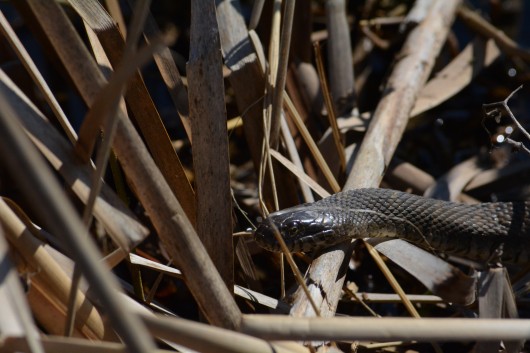A few weeks ago the core group members, a few of PI’s, and I met over the internet and chatted about the upcoming summer. After going over logistics, basic information, and introductions, John gave us our first assignment. He asked that each of us spend some time in a natural area and think a little about what questions that place might inspire in us. Something of a prep for the “But what is the question?!” mindset of Polaris.
Luckily for me, I wound up filming in the Sterling Nature reserve on the shores of Lake Ontario this week for my Eco-Cinema class. Shooting was going well, we saw a pair of tundra swans enjoying the fresh spring sun and a continual stream of red-winged blackbirds displaying against each other. My classmates and I were laughing about something or another as we traipsed down the trail towards a Heron nesting site we were told about when-

A northern water snake by Lake Ontario
“Snake!”
It wasn’t a scream, it wasn’t aggressive, it was just a shout in that same “oof” voice people make when they accidentally walk into something. A three foot long snake glided along the path in front of us, his dark black back contrasting his many-colored belly. We all froze in our tracks, and in the manner of environmental students out of our element in an artistic setting, fumbled with our cameras to line up our shots.
I was quietly grateful that I was equipped with a tripod and decent zoom-lens. I had no problem with taking my shot from a few good paces back. As a junior in conservation biology, it brings me slight shame to admit that I have a fear of snakes. I can’t pin down when it started exactly, and it is utterly unfair considering my utter lack of bad encounters with snakes, but it is present and something I’m aware of.
We decided the crowd of tall apes was bugging the snake, so we dropped a gopro to observe his actions without us there, and made our way down to the Heron Rookery. When I returned to retrieve my camera, the snake was nowhere to be seen, but I still walked slowly scanning everywhere I placed my foot, my legs bent, ready to spring back at the sight of movement. Let me point out too, this was not a rattler or anything, our snake was a northern water snake; a non-venomous frog-eater.
ESF’s herpetology professor says that as much as a 1/3 of the world has an irrational fear of snakes. It could be a vestige of our ancient mammal ancestors being devoured by reptiles, or even more recently primates and the risk they run of encounters with snakes in the trees. Historically, someone who ran up and poked a snake might have had less survival chance than one who ran up a tree when he saw anything slither. Now it might seem silly, but then it was a selective advantage: an adaptation.
This is my long-winded way of saying that we are all born with biases about nature, and we have to be aware of them. A personal fear of snakes is not a reason to neglect their assessment in management and ecological considerations. It just means we’ve evolved to worry about them, and we need to actively fight that instinct if trying to conserve them. For the arctic, particularly my project in Pleistocene Park, it’s easy to get caught up in the big stars: the musk-ox, horses, and moose. But it’s important to recognize this bias for what we can instantly see, and recognize there are other factors to consider, things like the microbial community, the soil’s properties, and the microinvertebrates that process it. Indeed, this is the essence of my study, how the large can change the small, and vice versa.
I’m looking forward to hearing about what everyone else thought about, and am more and more excited for July.



